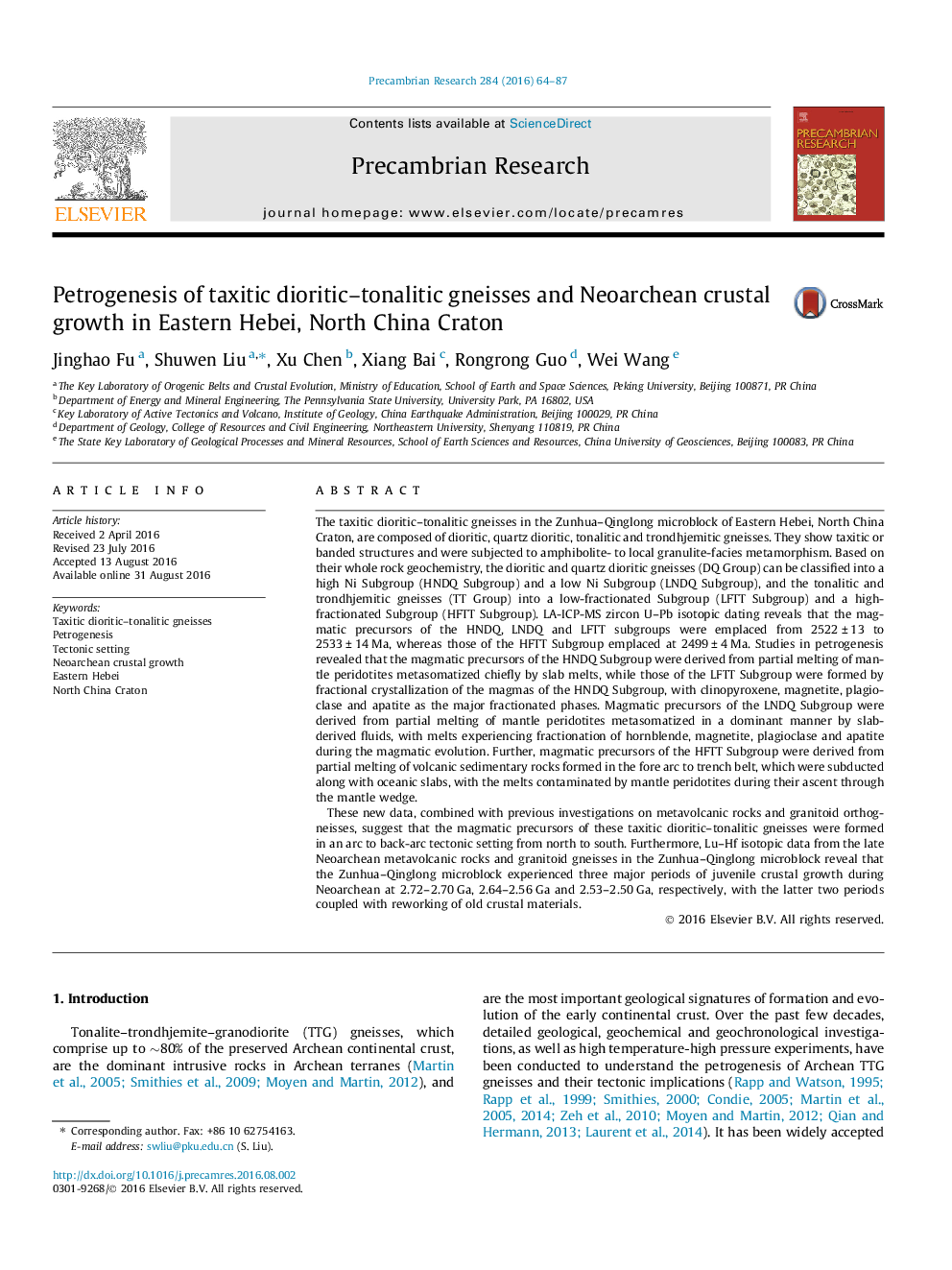| کد مقاله | کد نشریه | سال انتشار | مقاله انگلیسی | نسخه تمام متن |
|---|---|---|---|---|
| 4722278 | 1639591 | 2016 | 24 صفحه PDF | دانلود رایگان |

• Magmatic precursors of taxitic dioritic–tonalitic gneisses emplaced at 2533–2499 Ma.
• HNDQ and LFTT subgroups originated from evolution of a same mantle derived magma.
• LNDQ Subgroup from partial melting of mantle wedge enriched by subducted fluids.
• HFTT Subgroup sourced from subducted volcanic sedimentary rocks.
• Neoarchean three periods of crust growth at 2.72–2.70, 2.64–2.56, 2.53–2.50 Ga in EHP.
The taxitic dioritic–tonalitic gneisses in the Zunhua–Qinglong microblock of Eastern Hebei, North China Craton, are composed of dioritic, quartz dioritic, tonalitic and trondhjemitic gneisses. They show taxitic or banded structures and were subjected to amphibolite- to local granulite-facies metamorphism. Based on their whole rock geochemistry, the dioritic and quartz dioritic gneisses (DQ Group) can be classified into a high Ni Subgroup (HNDQ Subgroup) and a low Ni Subgroup (LNDQ Subgroup), and the tonalitic and trondhjemitic gneisses (TT Group) into a low-fractionated Subgroup (LFTT Subgroup) and a high-fractionated Subgroup (HFTT Subgroup). LA-ICP-MS zircon U–Pb isotopic dating reveals that the magmatic precursors of the HNDQ, LNDQ and LFTT subgroups were emplaced from 2522 ± 13 to 2533 ± 14 Ma, whereas those of the HFTT Subgroup emplaced at 2499 ± 4 Ma. Studies in petrogenesis revealed that the magmatic precursors of the HNDQ Subgroup were derived from partial melting of mantle peridotites metasomatized chiefly by slab melts, while those of the LFTT Subgroup were formed by fractional crystallization of the magmas of the HNDQ Subgroup, with clinopyroxene, magnetite, plagioclase and apatite as the major fractionated phases. Magmatic precursors of the LNDQ Subgroup were derived from partial melting of mantle peridotites metasomatized in a dominant manner by slab-derived fluids, with melts experiencing fractionation of hornblende, magnetite, plagioclase and apatite during the magmatic evolution. Further, magmatic precursors of the HFTT Subgroup were derived from partial melting of volcanic sedimentary rocks formed in the fore arc to trench belt, which were subducted along with oceanic slabs, with the melts contaminated by mantle peridotites during their ascent through the mantle wedge.These new data, combined with previous investigations on metavolcanic rocks and granitoid orthogneisses, suggest that the magmatic precursors of these taxitic dioritic–tonalitic gneisses were formed in an arc to back-arc tectonic setting from north to south. Furthermore, Lu–Hf isotopic data from the late Neoarchean metavolcanic rocks and granitoid gneisses in the Zunhua–Qinglong microblock reveal that the Zunhua–Qinglong microblock experienced three major periods of juvenile crustal growth during Neoarchean at 2.72–2.70 Ga, 2.64–2.56 Ga and 2.53–2.50 Ga, respectively, with the latter two periods coupled with reworking of old crustal materials.
Figure optionsDownload as PowerPoint slide
Journal: Precambrian Research - Volume 284, October 2016, Pages 64–87